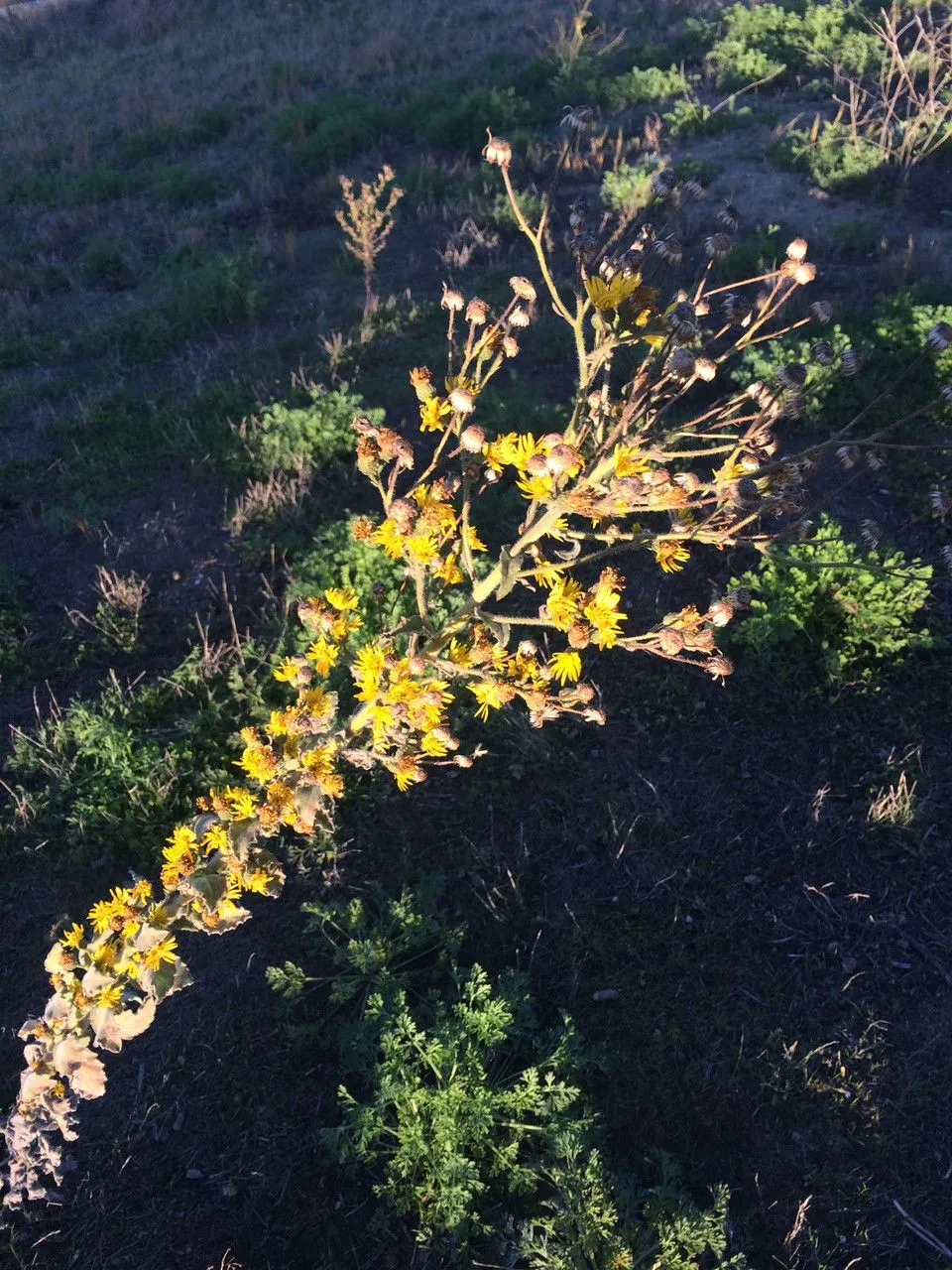
Author: Nutt.
Bibliography: Trans. Amer. Philos. Soc., ser. 2, 7: 315 (1840)
Year: 1840
Status: accepted
Rank: species
Genus: Heterotheca
Vegetable: False
Observations: SW. U.S.A.
Telegraph-weed, known scientifically as Heterotheca grandiflora, is a fascinating member of the Asteraceae family. This resilient plant was first documented in 1840 by the botanist Nutt. It thrives predominantly in the southwestern regions of the United States, showcasing its adaptability to various environmental conditions found in that part of the country.
Heterotheca grandiflora is recognizable by its vivid, yellow flowers that resemble small sunflowers, typical of the composite family to which it belongs. The flower heads are composed of both ray florets and disk florets, a characteristic feature of the Asteraceae family. The leaves of Telegraph-weed are alternately arranged on the stem, and the plant often exhibits a rough, hairy texture, which is an adaptation to its usually arid habitat, helping to reduce water loss.
This plant is also noteworthy for its role in the ecosystem. It provides a valuable nectar source for a variety of pollinators, including bees and butterflies, thus contributing to the pollination of other plants in its environment. Furthermore, its ability to grow in disturbed soils makes it an important species for revegetation efforts in areas that have experienced environmental disruption.
Despite its somewhat weedy appearance, Telegraph-weed has a subtle beauty and ecological significance that makes it an interesting subject of study for botanists and plant enthusiasts alike. Its presence in the southwestern United States serves as a reminder of the region’s rich botanical diversity and the important ecological roles played by even the most seemingly inconspicuous plants.
The documentation of Heterotheca grandiflora in the early 19th century by Nuttall, as referenced in the Transactions of the American Philosophical Society, highlights the long-standing recognition of this plant’s uniqueness and the ongoing interest in its study and classification within the plant kingdom.
Eng: telegraphweed, silk-grass golden-aster, telegraph-weed, telegraph plant
En: Telegraph-weed, Silk-grass golden-aster, Telegraphweed, Telegraph plant, Telegraph weed
Taken Oct 24, 2014 by EOL − Keir Morse (cc-by-nc-sa)
Taken Feb 24, 2021 by Elena Antonenko (cc-by-sa)
Taken Sep 15, 2020 by Bigfoot (cc-by-sa)
Taken Jun 7, 2020 by Lauren Holloway (cc-by-sa)
Taken Jun 17, 2019 by Wynne Will (cc-by-sa)
Taken Nov 9, 2022 by Taylor Seamount (cc-by-sa)
Taken Aug 13, 2013 by EOL − Eric Jacob (cc-by-nc)
Taken Nov 29, 2011 by EOL − Chris Cook (cc-by-nc)
Taken Sep 15, 2020 by Bigfoot (cc-by-sa)
Taken Aug 27, 2020 by andres amaya (cc-by-sa)
Taken Dec 16, 2015 by EOL − Donna Pomeroy (cc-by-nc)
Taken Nov 18, 2015 by EOL − James Bailey (cc-by-nc)
Taken Nov 18, 2015 by EOL − James Bailey (cc-by-nc)
Taken Nov 18, 2015 by EOL − Jesse Rorabaugh (cc-by)
Taken Nov 17, 2015 by EOL − matthew_salkiewicz (cc-by-nc)
Taken Dec 14, 2008 by EOL − Keir Morse (cc-by-nc-sa)
Taken Sep 14, 2011 by EOL − Zoya Akulova (cc-by-nc)
Taken Sep 14, 2011 by EOL − Zoya Akulova (cc-by-nc)
Taken Jan 1, 1900 by EOL − Forest & Kim Starr (cc-by)
Taken Oct 6, 2004 by EOL − Cheri Miller (cc-by-nc)
Taken Jun 18, 2022 by M Keller (cc-by-sa)
Taken Nov 17, 2015 by EOL − matthew_salkiewicz (cc-by-nc)
Taken Jan 9, 2016 by EOL − paloma (cc-by-nc)
Taken Aug 5, 2015 by EOL − Damon Tighe (cc-by-nc)
© copyright of the Board of Trustees of the Royal Botanic Gardens, Kew.
© copyright of the Board of Trustees of the Royal Botanic Gardens, Kew.
Growth habit>: Forb/herb
Family: Myrtaceae Author: (F.Muell.) K.D.Hill & L.A.S.Johnson Bibliography: Telopea 6: 402 (1995) Year: 1995 Status:…
Family: Rubiaceae Author: Pierre ex A.Froehner Bibliography: Notizbl. Bot. Gart. Berlin-Dahlem 1: 237 (1897) Year:…
Family: Sapindaceae Author: Koidz. Bibliography: J. Coll. Sci. Imp. Univ. Tokyo 32(1): 38 (1911) Year:…
Family: Asteraceae Author: A.Gray Bibliography: Pacif. Railr. Rep.: 107 (1857) Year: 1857 Status: accepted Rank:…
Family: Fabaceae Author: Medik. Bibliography: Vorles. Churpfälz. Phys.-Ökon. Ges. 2: 398 (1787) Year: 1787 Status:…
Family: Aspleniaceae Author: (Cav.) Alston Bibliography: Bull. Misc. Inform. Kew 1932: 309 (1932) Year: 1932…